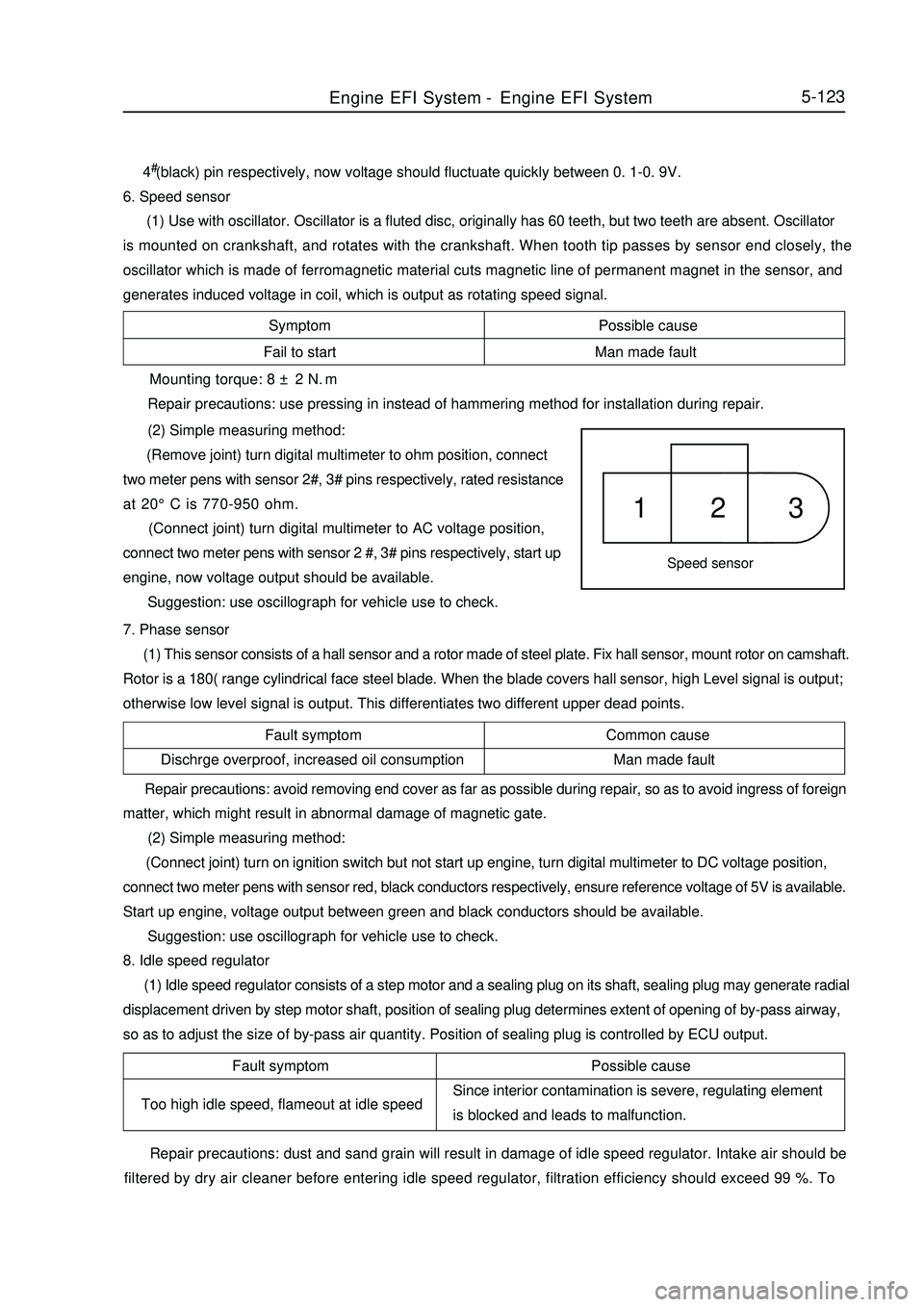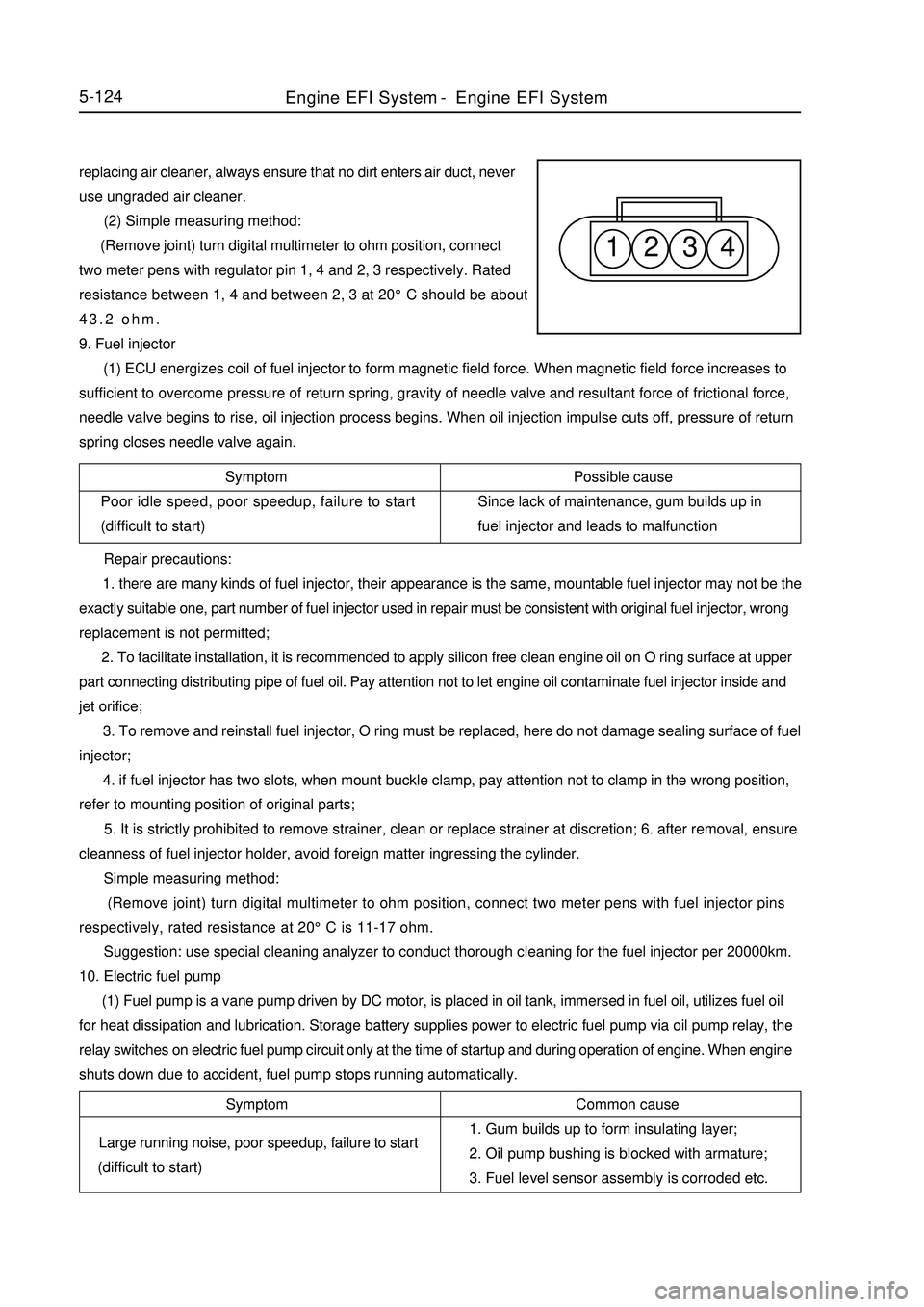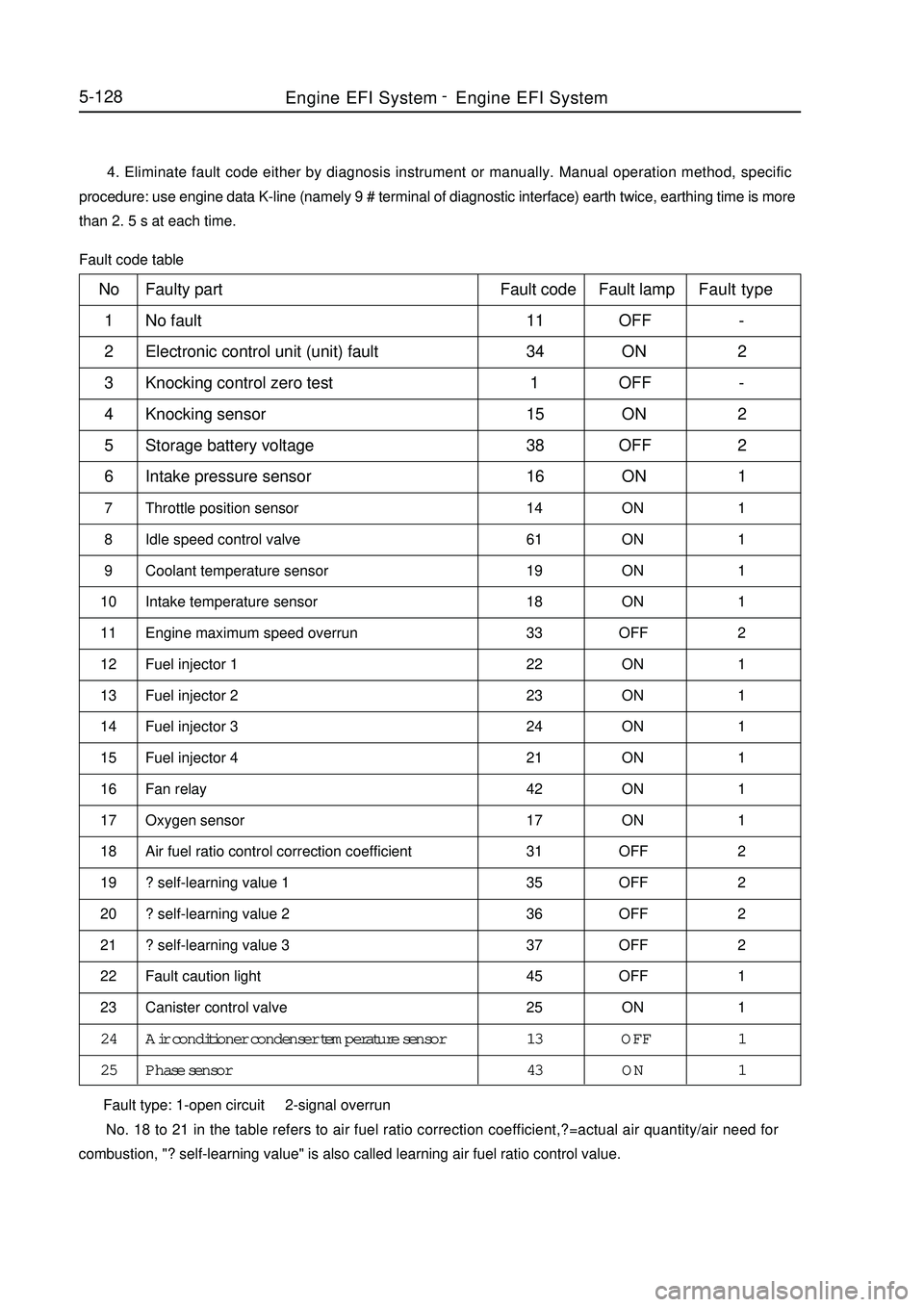2008 GEELY MK sensor
[x] Cancel search: sensorPage 309 of 416

4. Knocking sensor
(1) Knocking sensor is a vibration acceleration sensor. Mounted on engine cylinder body. Sensing element of
the sensor is a piezocrystal. Vibration of engine cylinder body is transferred to piezocrystal via mass block in the
sensor. Since pressure generated by vibration of mass block is applied to piezocrystal, it generates voltage on two
polar planes and turns vibration signal into voltage signal for output.5-122Symptom
Poor accelerationPossible cause
Various liquids, such as engine oil, cooling fluid, brake fluid, water etc
contact the sensor for a long time, which cause corrosion to the sensor. Mounting torque: 20 ± 5 N.M
Repair precautions: sensor must be fitted closely to cylinder body with its metal surface, any type of washer
is not permitted for installation. For wiring of sensor signal cables, note that do not let resonance occur to signal
cables, otherwise they might be broken. Energizing of high voltage between sensor 1 # and 2 # pins must be
avoided, otherwise piezoelectric element might be damaged.
(2) Simple measuring method:
(Remove joint) turn digital multimeter to ohm position, connect two meter pens with sensor 1 #, 2 # pin
respectively, its resistance value at room temperature should exceed 1M ohm. Turn digital multimeter to millivolt
position, use a hand hammer to tap near knocking sensor, now voltage signal output should be available.
5. Oxygen sensor
(1) Its sensing element is a ceramic tube, outside is open to exhaust, inside is open to atmosphere. When
temperature of sensing ceramic tube reaches 350°C, it will have the characteristic of solid state electrolyte. Just
utilizing this characteristic, it converts concentration difference of oxygen into electric potential difference, thus
forms electrical signal output. If mixed gas is a bit concentrated, inside and outside oxyanion concentration
difference of ceramic tube is high, electric potential difference is a bit high.
A large number of oxyanions move from inside to outside, output voltage is high (approximate 900mV); if
mixed gas is a bit thin, inside and outside oxyanion concentration difference of ceramic tube is low, electric
potential difference is low, only a small quantity of oxyanions move from inside to outside, output voltage is low
(approximate 100mV).
Possible cause
1. humid water vapor ingresses inside of sensor, temperature
changes rapidly, probe is broken.
2. oxygen sensor "is poisoned". (Pb, S, Br, Si) Symptom
Poor idle speed, poor speedup, tail gas
overproof, too high oil consumption1 2 3 4Oxygen sensor Mounting torque: 40-60 N.m
Repair precautions: it is prohibited to use cleaning fluid, oily liquid or volatile solid on oxygen sensor during
repair.
(2) Simple measuring method:
(Remove joint) turn digital multimeter to ohm position, connect
two meter pens with sensor 1# (white), 2# (white) pin respectively, its
resistance value at room temperature is 1- 6 ohm.
(Connect joint) in idle speed condition, when oxygen sensor
reaches its working temperature of 350°C, turn digital multimeter to
DC voltage position, connect two meter pens with sensor 3# (grey),Engine EFI System-Engine EFI System
Page 310 of 416

Symptom Possible cause
Fail to start Man made faultSpeed sensor1 2 3Fault symptom Common cause
Dischrge overproof, increased oil consumption Man made fault5-1234#(black) pin respectively, now voltage should fluctuate quickly between 0. 1-0. 9V.
6. Speed sensor
(1) Use with oscillator. Oscillator is a fluted disc, originally has 60 teeth, but two teeth are absent. Oscillator
is mounted on crankshaft, and rotates with the crankshaft. When tooth tip passes by sensor end closely, the
oscillator which is made of ferromagnetic material cuts magnetic line of permanent magnet in the sensor, and
generates induced voltage in coil, which is output as rotating speed signal. Mounting torque: 8 ± 2 N.m
Repair precautions: use pressing in instead of hammering method for installation during repair.
(2) Simple measuring method:
(Remove joint) turn digital multimeter to ohm position, connect
two meter pens with sensor 2#, 3# pins respectively, rated resistance
at 20°C is 770-950 ohm.
(Connect joint) turn digital multimeter to AC voltage position,
connect two meter pens with sensor 2 #, 3# pins respectively, start up
engine, now voltage output should be available.
Suggestion: use oscillograph for vehicle use to check.
7. Phase sensor
(1) This sensor consists of a hall sensor and a rotor made of steel plate. Fix hall sensor, mount rotor on camshaft.
Rotor is a 180( range cylindrical face steel blade. When the blade covers hall sensor, high Level signal is output;
otherwise low level signal is output. This differentiates two different upper dead points. Repair precautions: avoid removing end cover as far as possible during repair, so as to avoid ingress of foreign
matter, which might result in abnormal damage of magnetic gate.
(2) Simple measuring method:
(Connect joint) turn on ignition switch but not start up engine, turn digital multimeter to DC voltage position,
connect two meter pens with sensor red, black conductors respectively, ensure reference voltage of 5V is available.
Start up engine, voltage output between green and black conductors should be available.
Suggestion: use oscillograph for vehicle use to check.
8. Idle speed regulator
(1) Idle speed regulator consists of a step motor and a sealing plug on its shaft, sealing plug may generate radial
displacement driven by step motor shaft, position of sealing plug determines extent of opening of by-pass airway,
so as to adjust the size of by-pass air quantity. Position of sealing plug is controlled by ECU output.Fault symptom
Too high idle speed, flameout at idle speedPossible cause
Since interior contamination is severe, regulating element
is blocked and leads to malfunction.
Repair precautions: dust and sand grain will result in damage of idle speed regulator. Intake air should be
filtered by dry air cleaner before entering idle speed regulator, filtration efficiency should exceed 99 %. ToEngine EFI System-Engine EFI System
Page 311 of 416

1 2 3 45-124replacing air cleaner, always ensure that no dirt enters air duct, never
use ungraded air cleaner.
(2) Simple measuring method:
(Remove joint) turn digital multimeter to ohm position, connect
two meter pens with regulator pin 1, 4 and 2, 3 respectively. Rated
resistance between 1, 4 and between 2, 3 at 20°C should be about
43.2 ohm.
9. Fuel injector
(1) ECU energizes coil of fuel injector to form magnetic field force. When magnetic field force increases to
sufficient to overcome pressure of return spring, gravity of needle valve and resultant force of frictional force,
needle valve begins to rise, oil injection process begins. When oil injection impulse cuts off, pressure of return
spring closes needle valve again.
Symptom
Poor idle speed, poor speedup, failure to start
(difficult to start)Possible cause
Since lack of maintenance, gum builds up in
fuel injector and leads to malfunction
Repair precautions:
1. there are many kinds of fuel injector, their appearance is the same, mountable fuel injector may not be the
exactly suitable one, part number of fuel injector used in repair must be consistent with original fuel injector, wrong
replacement is not permitted;
2. To facilitate installation, it is recommended to apply silicon free clean engine oil on O ring surface at upper
part connecting distributing pipe of fuel oil. Pay attention not to let engine oil contaminate fuel injector inside and
jet orifice;
3. To remove and reinstall fuel injector, O ring must be replaced, here do not damage sealing surface of fuel
injector;
4. if fuel injector has two slots, when mount buckle clamp, pay attention not to clamp in the wrong position,
refer to mounting position of original parts;
5. It is strictly prohibited to remove strainer, clean or replace strainer at discretion; 6. after removal, ensure
cleanness of fuel injector holder, avoid foreign matter ingressing the cylinder.
Simple measuring method:
(Remove joint) turn digital multimeter to ohm position, connect two meter pens with fuel injector pins
respectively, rated resistance at 20°C is 11-17 ohm.
Suggestion: use special cleaning analyzer to conduct thorough cleaning for the fuel injector per 20000km.
10. Electric fuel pump
(1) Fuel pump is a vane pump driven by DC motor, is placed in oil tank, immersed in fuel oil, utilizes fuel oil
for heat dissipation and lubrication. Storage battery supplies power to electric fuel pump via oil pump relay, the
relay switches on electric fuel pump circuit only at the time of startup and during operation of engine. When engine
shuts down due to accident, fuel pump stops running automatically.Symptom
Large running noise, poor speedup, failure to start
(difficult to start)Common cause
1. Gum builds up to form insulating layer;
2. Oil pump bushing is blocked with armature;
3. Fuel level sensor assembly is corroded etc.Engine EFI System-Engine EFI System
Page 313 of 416

Engine ECU5-126as to avoid damaging electronic control unit.
(1) Simple measuring method:
(Remove joint) turn digital multimeter to ohm position, connect two meter pens with primary winding pinsrespectively, rated resistance at 2 0°C is 0. 4-0. 6 ohm for 2X2 type; on secondary winding, 11-15k ohm for 2x2 type.13. Electronic control unit ECU
Possible cause
Electric overload of externally connected
device leads to burnout of components inside
ECU and results in malfunction Symptom
Unsteady idle speed, poor speedup, failure to start, too high
idle, tail gas overproof, difficult to start, malfunction of air
conditioner, malfunction of fuel injector control, flameout
Repair precautions:
1. Don't remove ECU at discretion during repair;
2. ECU may be removed more than 1 minute after removing storage battery head;
3. Store removed ECU properly;
4. It is prohibited to attach any circuit onto connecting wire of ECU.
Simple measuring method:
1. (Connect joint) use engine data K-line to read engine trouble record;
2. (Remove joint) check whether ECU connecting wire is in good condition or not, mainly check whether ECU
power supply grounded circuit is normal or not;
3. Check whether external sensor works normally, whether output signal is credible, whether circuit is in good
condition;
4. Check whether actuator works normally, whether its circuit is in good condition;
5. Finally replace ECU to conduct test.
Judgment principle: "two interchange principle" ---interchange ECU, interchange fault symptom.III. Diagnostic system Description:
When engine ECU detects a trouble, engine trouble warning lamp on instrument will illuminate. In addition,
relevant diagnostic code will be recorded in ECU memory. Connect handheld tester with diagnostic interface on
automobile, read various data from automobile ECU. Connect handheld tester with diagnostic interface. Technical
personnel may also read fault code via blinking of instrument fault warning lamp.Engine EFI System-
Engine EFI System
Page 314 of 416

Flashing way of malfuntion code 17 for O2 sensor (3) Each fault code will blink for three times, interval time is 3s, after blinking for the third times, after an
interval of 3s, next fault code will blink. After blinking of all fault codes is finished, they will blink from begining
again. The following diagram shows engine fault warning lamp blinking mode for oxygen sensor fault code 17.5-127Terminal No. Terminal definition
4 Power supply (-)
7 Bus (signal)
16 Power supply (+)Diagnosis connector Notes: use tester cable to connect handheld tester with diagnostic interface, turn ignition switch to ON position,
operate tester, if tester displays that communication is not possible, the vehicle or tester fails.
Inspection diagnosis
1. Check engine fault warning lamp
(1) When ignition switch is turned to ON position and engine does not run, engine warning lamp on
instrument should illuminate.
(2) When engine runs, engine fault warning lamp should go out. If it still illuminates, diagnostic system
detects system fault or abnormity.
2. Use handheld tester to check diagnostic code
(1) Connect handheld tester according to corresponding pin.
(2) Turn ignition switch to ON position, turn on main switch of handheld tester.
(3) Use handheld tester to detect and check diagnostic code, refer to fault diagnostic code table. (For
operation of handheld tester, see instruction manual of handheld tester)
3. Engine fault warning lamp displays fault code through blinking code, so professional may make fault
judgment in case of emergency.
(1)Turn ignition switch to ON position.
(2) Short signal pin (9#) and negative pole (4#) for more than 2. 5s,then disconnect them,detection fault lamp
on dashboard will blink the faults in fault code according to their occurrence sequence.See from terminal outlet
endConnect in jump way over 2.5s and
disconnect
Diagnosis connectorDiagnosis connectorEngine EFI System-
Engine EFI System
Page 315 of 416

No
1
2
3
4
5
6
7
8
9
10
11
12
13
14
15
16
17
18
19
20
21
22
23
24
255-128 4. Eliminate fault code either by diagnosis instrument or manually. Manual operation method, specific
procedure: use engine data K-line (namely 9 # terminal of diagnostic interface) earth twice, earthing time is more
than 2. 5 s at each time.
Fault code tableFaulty part
No fault
Electronic control unit (unit) fault
Knocking control zero test
Knocking sensor
Storage battery voltage
Intake pressure sensor
Throttle position sensor
Idle speed control valve
Coolant temperature sensor
Intake temperature sensor
Engine maximum speed overrun
Fuel injector 1
Fuel injector 2
Fuel injector 3
Fuel injector 4
Fan relay
Oxygen sensor
Air fuel ratio control correction coefficient
? self-learning value 1
? self-learning value 2
? self-learning value 3
Fault caution light
Canister control valve
Air conditioner condenser temperature sensor
Phase sensorFault code
11
34
1
15
38
16
14
61
19
18
33
22
23
24
21
42
17
31
35
36
37
45
25
13
43Fault lamp
OFF
ON
OFF
ON
OFF
ON
ON
ON
ON
ON
OFF
ON
ON
ON
ON
ON
ON
OFF
OFF
OFF
OFF
OFF
ON
OFF
ONFault type
-
2
-
2
2
1
1
1
1
1
2
1
1
1
1
1
1
2
2
2
2
1
1
1
1
Fault type: 1-open circuit 2-signal overrun
No. 18 to 21 in the table refers to air fuel ratio correction coefficient,?=actual air quantity/air need for
combustion, "? self-learning value" is also called learning air fuel ratio control value.Engine EFI System-
Engine EFI System
Page 318 of 416

Rear Parking Radar System-Rear Parking Radar System5-131Ultrasonic sensor
Ultrasonic sensor
Receiving AmplifierTransmitting Amplifier Receiving AmplifierTransmitting AmplifierPhonetic circuitMCU
Receive, filter and amplifyDisplay
Electric A/D switchChapter 11 Rear Parking Radar SystemI. System principle Reversing radar system mainly adopts ultrasonic ranging technology, utilizes piezoelectric property of
transducer (ultrasonic sensor), excites piezo sheet with voltage with frequency of 40KHZ intermittently, this piezo
sheet is then converted from electric energy to mechanical energy and sent out. When emitted sound wave contacts
object, it will reflect weak sound wave energy to transducer according to sound wave reflection principle, i. e.
convert received weak acoustic vibration signal to electrical signal, after signal amplification processing, it is
transmitted to microprocessor to calculate the distance between vehicle and this object and display the distance.
Then microprocessor determines whether to give caution remind for dangerous object according to varying
degrees.II. Circuit diagramPlease Refer to "MK WIRING DIAGRAM"
Page 319 of 416

III. Fault diagnosis 1. During detection, if there is no sound or display screen does not illuminate, please detect whether polarity
of power supply is connected in a wrong way, whether power cord is connected, whether supply voltage 9V,
whether display joint is inserted properly.
2. If clobber "0.0" or constant ringing occurs, please exit reverse gear, engage reverse gear again. If the
above symptom still exists, it may be deemed that principal machine is damaged, and should be replaced
completely.
3. If certain value is displayed, while there is no evident barrier at right ahead of probe. Prominence on or rear
might be detected (such as license plate, bumper bar etc). please check whether direction axis of the probe is
correct, horizontal axis of the probe should slightly upwarp.
4. When accelerating, the installed display shows irregular disordered frame, circuit interference might occur,
check earth wire of reversing radar.IV. Installation of reversing radar 1. Reversing radar system consists of reversing radar principal machine, reversing radar display screen, wiring
harness, buckle and reversing radar probe etc.Rear Parking Radar System-
Rear Parking Radar System5-132About 500 mm
About 265 mmRear parking radarsensor
Clip
Push Rear bumper bar